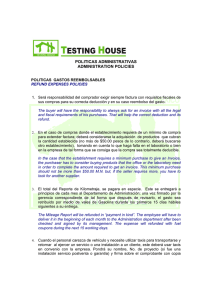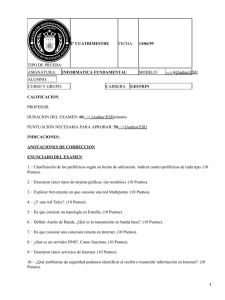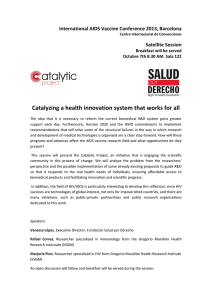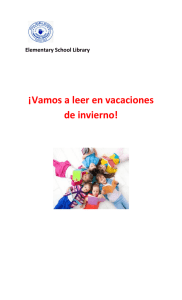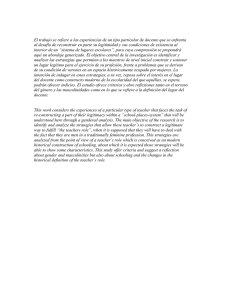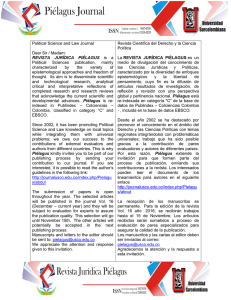NORMAS DE PUBLICACIÓN Las colaboraciones se encuentran
Anuncio
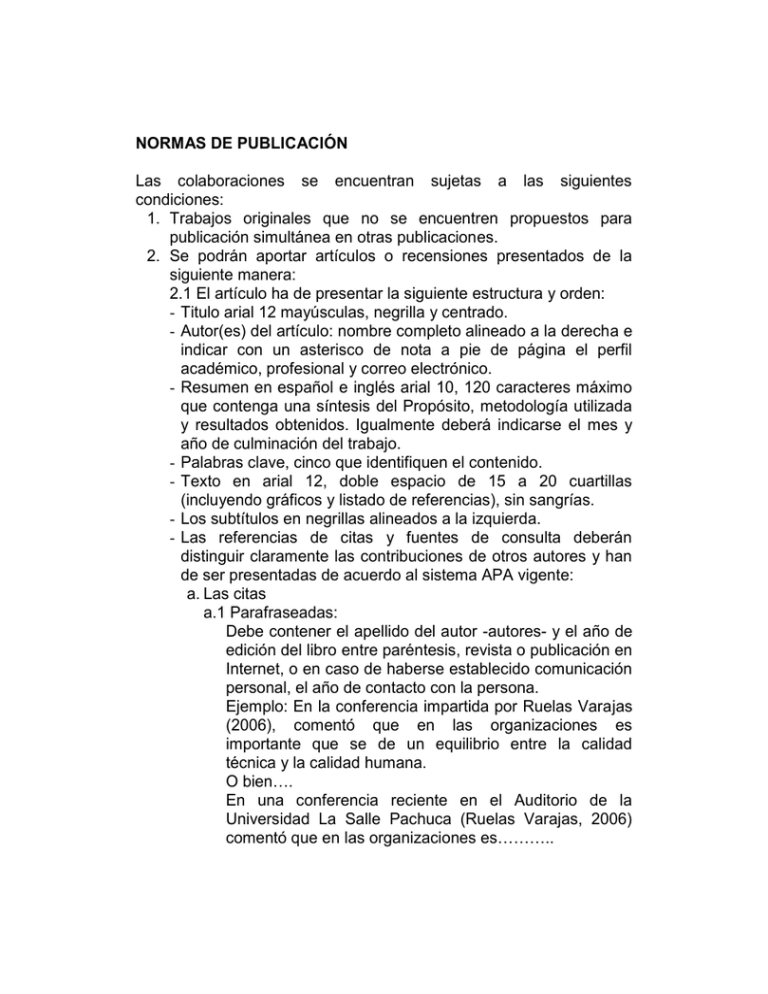
NORMAS DE PUBLICACIÓN Las colaboraciones se encuentran sujetas a las siguientes condiciones: 1. Trabajos originales que no se encuentren propuestos para publicación simultánea en otras publicaciones. 2. Se podrán aportar artículos o recensiones presentados de la siguiente manera: 2.1 El artículo ha de presentar la siguiente estructura y orden: - Titulo arial 12 mayúsculas, negrilla y centrado. - Autor(es) del artículo: nombre completo alineado a la derecha e indicar con un asterisco de nota a pie de página el perfil académico, profesional y correo electrónico. - Resumen en español e inglés arial 10, 120 caracteres máximo que contenga una síntesis del Propósito, metodología utilizada y resultados obtenidos. Igualmente deberá indicarse el mes y año de culminación del trabajo. - Palabras clave, cinco que identifiquen el contenido. - Texto en arial 12, doble espacio de 15 a 20 cuartillas (incluyendo gráficos y listado de referencias), sin sangrías. - Los subtítulos en negrillas alineados a la izquierda. - Las referencias de citas y fuentes de consulta deberán distinguir claramente las contribuciones de otros autores y han de ser presentadas de acuerdo al sistema APA vigente: a. Las citas a.1 Parafraseadas: Debe contener el apellido del autor -autores- y el año de edición del libro entre paréntesis, revista o publicación en Internet, o en caso de haberse establecido comunicación personal, el año de contacto con la persona. Ejemplo: En la conferencia impartida por Ruelas Varajas (2006), comentó que en las organizaciones es importante que se de un equilibrio entre la calidad técnica y la calidad humana. O bien…. En una conferencia reciente en el Auditorio de la Universidad La Salle Pachuca (Ruelas Varajas, 2006) comentó que en las organizaciones es……….. a.2 Textuales: En estas citas es imprescindible que engloben además de autor y año, la página o páginas de donde se obtuvo. Las citas textuales pueden ser: a.2.1 Textual corta: El texto que se transcribe debe estar entre comillas. Ejemplo: Toussaint (2000, p.13) señala que: “A partir del funcionalismo surge, por primera vez en la historia de la sociología, el estudio de los medios de masa y de sus efectos en el público”. a.2.2 Textual larga: Cuando la cita textual presenta más de 40 palabras se requiere presentarla en un párrafo independiente con letra dos puntos más pequeña en tamaño, sin comillas y con sangría en todo el párrafo. Ejemplo: Como señala Toussaint (2000, p.16) sobre la transmisión de informaciones: (…) provenientes de los medios de masas a los líderes, y de éstos a sus seguidores, se denomina “flujo de comunicación en dos pasos”. Sin embargo, los fenómenos de comunicación en el liderazgo de opinión adquieren el carácter de “pasos múltiples”, debido a la existencia de repetidores de las afirmaciones de los líderes, quieres por su parte también buscarán las opiniones de otras personas. a.3 Cita sobre algo que ya ha sido citado. En la fuente consultada se requiere señalarse así: Toussaint (1964 en Schramm, 2002) indica que “la fuente puede ser una persona (que habla, escribe, dibuja o hace gestos) o una organización informativa (un periódico, una casa editora, una estación de televisión o un estudio de cine”. En el listado de referencias únicamente de incluirse el texto que se consultó directamente (en este caso, el de Schramm). a.3.1 Cuando la fuente original tiene dos autores, siempre se citan ambos Ejemplo: (Moles y Zeltmann, 1973). a.3.2 Cuando son entre tres y cinco, la primera vez se colocan todos, pero en las siguientes referencias, sólo se engloba el apellido del primer autor y et al Ejemplo: Morales, et al.(2006) proponen que… a.3.3 Cuando se trata de una fuente con seis o más autores, desde la primera cita se pone sólo el primer autor y et al. Ejemplo: Best, et al. (2005) concluyeron que… a.4 Si se utilizan dos fuentes del mismo autor y publicadas en el mismo año, se requiere identificarlas con letra Ejemplo: Phillips (2004a y 2004b) propone una clasificación…… a.5 Citas de trabajos clásicos, se pone el año de la traducción, además del año del libro que se examinó Ejemplo: (Platón traducido en 1966), Villalobos (2003) a.6 La cita de la información obtenida en una entrevista debe mencionar el apellido del entrevistado, el tema, y la fecha Ejemplo: Arteaga (Revista Impulsa, 12 de Febrero de 2006). b. Las Fuentes de Consulta. Se colocan alfabéticamente por apellido paterno autor, solo se incluyen aquellos textos que fueron enunciados durante la redacción del informe de investigación. b.1 Publicación periódica (abarca el número de la publicación y al final la página inicial y final) Autor, I. (año de publicación). Título del artículo. Título de la revista en cursiva, xx, xx-xx. Ejemplo: Giraudo, L. (2006). Entre representaciones y realidad: maestros indígenas y maestras rurales. Veracruz, 1930. Sinética, 28, 41-53. b.2 Libro: Autor, (año de publicación). Título del libro en cursivas. Localidad, país: Editorial. Ejemplo: Kerlinger, F (2002). Investigación del comportamiento. Métodos de investigación en ciencias sociales, México: McGraw-Hill b.3 Capítulo dentro de un libro compilado. Apellido del autor del capítulo, I (año). Título del capítulo, En Apellido del compilador (Ed). Título del libro en cursivas (p. xx-xx). Localidad, país: Editorial. Ejemplo: Márquez G. (2002). “Situación de la educación en México”, En D. Claudio (Coord.) El Modelo educativo, (pp. 38-50). Pachuca, México: Universidad Autónoma del estado de Hidalgo b.4 Documento electrónico: Autor, I., (año). Título del trabajo en cursivas. Recuperado día, mes y año, de la fuente. Ejemplo: Cano M (2003). La investigación colaboratíva en Educación Recuperado el 12 de mayo 2006, de http://www.uv.mx/iiesca/revista/SUMA025.html b.5 Publicación electrónica periódica: Apellido, I. (año). Título del artículo. Título de la publicación en cursivas, xx, xxx-xxx, recuperado día, mes y año, de la fuente. Ejemplo: Rodríguez R. (2004). En busca del equilibrio. Calidad y Equidad en la Educación. Observatorio Ciudadano de la educación A.C. Recuperado el 12 de mayo de 2006, de http://www.ocdemexico.org.mx/ForoOCDE/Docs/roberto. pdf 2.2 En caso de participar con una recensión seguir la siguiente estructura: - Cabeza. En la primera línea: título de libro en cursivas, nombre completo del autor del mismo, editorial y año; en la segunda línea: nombre completo del autor de la recesión y su correo electrónico. - Texto. Extensión máxima tres cuartillas, debe dar cuenta del contenido de la obra con detalle y expresar un juicio crítico fundamentado sobre la misma. - Anexar la imagen de la portada del libro en formato jpg 3. Gráficos o tablas entregarlas en otro archivo del mismo disco, en blanco y negro, numeradas en forma seriada, sin color ni sombras, en arial 10 y señalar en el texto con rojo su ubicación. En el caso de las imágenes enviarlas en formato JPEG con los colores, proporción y tamaño originales. A pie del gráfico, tabla o imagen señalar el título o breve explicación de su contenido, autor de la misma y fuente de donde se extrajo. 4. La revista requiere que los autores cedan sus derechos de autoría con el propósito de que su contribución sea reproducida y distribuida para su difusión de manera impresa y digital con fines científicos y culturales y sin fines de lucro; para ello, se enviará al autor un formato digital que deberá ser devuelto con su firma. Se integrará en el mismo, los siguientes datos: nombre completo del autor, formación académica, Institución a la que pertenece, dirección de la misma, cargo y correo electrónico. Señalar mes y año en que se culminó el trabajo y fecha de envío del mismo. 5. Los manuscritos se adaptarán a las normas de edición de la revista, con un máximo de 30 cuartillas a espacio y medio incluyendo tablas, gráficos y fuentes de consulta. Se podrán hacer las correcciones de estilo que contribuyan a mejorar la redacción del texto. El orden de publicación dependerá de la temática general de cada número de revista. 6. Se realizará el siguiente proceso para valorar la calidad de los trabajos a publicar: sólo se llevarán al sistema de arbitraje aquellas aportaciones que cumplan estrictamente las indicaciones antes descritas mismas que serán revisadas en dictamen interno por un evaluador, si la valoración es satisfactoria; se enviará a dos especialistas académicos para dictamen externo, quienes evaluarán de manera anónima los trabajo de acuerdo a criterios de pertinencia, originalidad, congruencia teórica y aporte académico. Se determinarán de manera anónima tres posibles fallos: publicable, publicable con modificaciones o no publicable. En caso de discrepancia sobre la evaluación se enviará a un tercer dictamen para definir su publicación. El dictamen final se le hará saber por escrito al autor, mismo que será inapelable. En caso de ser publicable con modificaciones se indicará de manera específica lo que habría que corregir otorgando 15 días más para retornar la versión final del mismo, en 15 días se le indicará la valoración final establecida por uno de los dictaminadores. 7. La revista está orientada a publicar principalmente reportes de investigación, sin embargo, se puede contribuir con 7.1 Reportes de investigación: Es el informe ya sea parcial o final de hallazgos encontrados como producto un estudio de investigación. Se ha de integrar: introducción, sustento teórico, metodología utilizada, resultados y conclusión. 7.2 Propuesta pedagógica: Es el diseño de una propuesta que se presenta como alternativa de respuesta a una situación de enseñanza aprendizaje a través de un trabajo concreto tomando en cuenta las consideraciones en que surge. Incluir argumento teórico y metodología de aplicación. 7.3 Experiencia didáctica: Contiene la recuperación de una experiencia de aprendizaje que coadyuve a la reflexión de situaciones sociales. Incluir la descripción de lo acontecido, argumento teórico, metodología aplicada y conclusiones obtenidas. 7.4 Recensiones: Es la reseña de una obra literaria o científica que en la revista Xihmai ha se ubicarse en el campo de la educativo o humanístico. Incluir los elementos esenciales que trata la obra y un comentario crítico del contenido de la misma. 8. La edición de la revista será reproducida por medios escritos y electrónicos por lo que pedimos enviar en archivo separado en el mismo CD los datos del autor(res): nombre completo, institución de filiación, dirección postal completa, teléfono, fax, apartado postal y correo electrónico. Cada autor recibirá 3 ejemplares de la misma y podrá acceder a ella en la página www.lasallep.edu.mx 9. Las aportaciones se entregarán en forma personal o enviados por e-mail, los archivos con el nombre de lo que contiene enseguida el apellido paterno del autor. PUBLICATION REGULATIONS Collaborations are abided by the following conditions: 1. Original work not proposed to be published simultaneously in other publications. 2. Articles or recessions can be presented in the following way: 2.1 The article has to be presented with the following structure and order: - Title arial 12 uppercase letter, bold and centered. - Article’s author (s): Full name aligned to the right and indicate with an asterisk as a page foot note the academic profile, professional and email address. - Summarize in Spanish and English arial 10, in maximum 120 characters a synthesis of the purpose, methodology used and results. In the same way it should be indicated month and year of end of work. - Key words, five that identify the content. - Text in arial 12, doble space from 15 to 20 pages (including graphics and reference list), without indentation. - Subtitles in bold aligned to the left. - Quoting references and sources of information should distinguish clearly other author’s contributions and have to be presented according to the current APA system: a. Quots a. 1 Paraphrased: It should contain among parentheses author’s – authorssurname, printing year of the book, magazine or publication in Internet, or in the case of having established personal communication, the year of contact with the person. For example: In the conference given by Ruelas Varajas (2006), it was commented that it is important to have equilibrium within technical quality and human quality in the organizations. Or… In a recent conference in the Auditorium of La Salle University Pachuca (Ruelas varajas, 2006) it was commented that in the organizations is… a. 2 Textual: In these quotes it is essential that besides author and year, page or pages should be globalized from where they were obtained. Textual quotes can be: a. 2.1 Short textual: The text that is transcribed should be in quotation marks. Example: Toussaint (2000, p. 13) points out that: “ From functionality comes, for the first time in sociology history, the study of the mass media and its effects in the audience”. a.2.2 Long textual: When the textual quote presents more than 40 words it is required to present it in an independent paragraph with a two-point smaller size letter, without quotation marks and with indentation in all the paragraph. Example: As Toussaint points out(2000, p.16) about the transmission of information: (…) coming out from the mass media to the leaders, and from these the their followers, it is named “ communication flow in two steps”. However, communication phenomenon in opinion leadership acquire the character of “multiple steps”, due to the existence of people repeating the leaders’ affirmations, who on the other hand will look for others’ opinions. a.3 Quote about something that has been quoted. In the source of information consulted it is necessary to point it out in this way: Toussaint (1964 in Schramm, 2002) indicates that “the source of information can be a person ( someone who speaks, writes, draws or makes gestures) or an informative organization ( a newspaper, a publisher’s, television or a film studio”. It must only be included in the list of references the text which was directly consulted ( in this case, the one of Schramm) a.3.1 When the original source of information has two authors both of them have to be quoted. Example: (Moles and Zeltmann, 1973). a.3.2 When it is among three and five, all of them must be named the first time, but in the following references, only the first author’s surname is globalized and et al. Example: Morales, et al. (2006) proposes that… a. 3.3 When it is a source of information of six or more authors, since the first quote only the first author and et al. Example: Best, et al. (2005) concluded that…. a. 4 If two sources of information from the same author are used and published in the same year, it is essential to differentiate them with a letter. Example: Phillips (2004a and 2004b) proposes a classification… a.5 Classic works quotes, the year of translation is included, besides the year in which the book was examined Example: (Platòn translated in 1966), Villalobos (2003) a. 6 The quote of the information obtained in an interview should mention the interviewee’s surname, subject and date. Example: Arteaga (Impulsa magazine, February 12th 2006). b. The works consulted. In alphabetical order according to the author’s surname, only those texts which were stated during the composition of the investigation inform have to be included. b.1 Periodical publication ( covers the publication number and the end the initial and final page) Author, I. (Publication year). Article’s title. Magazine’s title in italics, xx, xx-xx. Example: Giraudo, L. (2006). Among representations and reality: native teachers and rural teachers. Veracruz, 1930. Sinetica, 28, 41-53. b. 2 Book: Author, (year of publication). Book title in italics. Town, country: Editorial. Example:Kerlinger, F (2002). Behavior research. Research methods in social sciences, Mexico: McGraw-hill b.3 Chapter inside a compiled book. Chapter’s author’s surname, I (year). Chapter’s title, Compiler’s surname (Ed). Book’s title in italics (p. xx-xx). Town, country: Editorial. Example: Márquez G. (2002). “Situation of education in Mexico”, In D. Claudio (Coord.) The Education Model, (pp. 38-50) Pachuca, Mexico: Autonomus University of Hidalgo. b. 4 Electronic document: Author, I., (year) Work’s title in italics. Day, month and year recovered from the source. Example: Cano m(2003). Colaborative research in th Education Recovered on May 12 2006, from http://www.uv.mx/iiesca/revista/SUMA025.html b.5 Periodical electronic publication: Surname, I. (year). Article’s title. Publication’s title in italics,xx, xxx-xxx, day, month and year of source recovering. Example: Rodríguez R. (2004). In search of equilibrium. Quality and Equity in Education. Citizen Observatory of th Education A. C. Recovered on May 12 2006, from de http://www.ocdemexico.org.mx/ForoOCDE/Docs/roberto.pdf 2.2 In the case of a published comment the following structure must be achieved: - Head. In the first line: book’s title in italics, author’s full name, editorial and year; on the second line: Full name of the author of the published comment and his/her e-mail address. - Text. Maximum length three pages, it should cover the content of work in detail and express a critical judgment backed up by itself. - Attach the book’s cover’s image in jpg format. 3. Graphics or charts have to be delivered in another file in the same disc, in black and white, numbered in serial, without color or shades, in arial 10 and pointing out its location in the text. In the case of images, they must be sent in JPEG format with the colors, proportion and original size. At graphic’s, chart’s or image’s bottom the title or brief explanation of its content must be given, author’s and source from where it was taken. 4. The magazine requires that authors assign their rights of authorship so that their contribution can be reproduced and distributed for its diffusion in written and digital ways in scientific and cultural purposes and without profit intentions; Therefore, a digital format will be sent to the author, this will have to be returned with his/her signature. In the document will be integrated the following information: author’s full name, academic formation, Institution to which he is a member, address, charge and e-mail address. Month and year of end of work must be given. 5. Manuscripts will have to adapt to the edition regulations of the magazine, with a maximum of 30 pages, one and a half space including charts, graphics and sources of information. Style corrections that contribute to improve the text composition can be done. The publication order will depend on the general subject matter in each number of magazine. 6. The following process will be made to assess the quality of the works to be published: Only those contributions which strictly accomplish the directions mentioned above will be taken to the judgment system, they will be revised under an intern report by an examiner, if the assessment is satisfying; it will be sent to two academic specialist for an external report, which will evaluate the works anonymously according to the pertinent criteria, originality, theory congruency and academic contribution. The three possible results will be determined anonymously: publishable, publishable with modifications or no publishable. In case of a discrepancy about the evaluation, it will be sent to a third report to define its publication. The final report will be given in a written way to the author, the same that will be un appealable. In case it can be publishable with modifications, it will be indicated specifically what has to be corrected assigning 15 days more to give the final version of it, in 15 days the final assessment will be indicated which will be established by one of the judges. 7. The magazine’s goal is to publish mainly investigation reports, however, it can contribute with 7.1 Investigation reports: It is the partial or final report of discoveries found as a result of an investigation study. Introduction, theory support, used methodology, results and conclusions have to be integrated. 7.2 Pedagogic proposal: It is the design of a proposal that is presented as an alternative in response to a situation in teaching and learning through concrete work taking into account the considerations in which it emerges. Theory argument and application methodology must be included. 7.3 Didactic experience: It contains the recovering of a learning experience that contributes to the reflection of social situations. A description of what happened, theory argument, applied methodology and conclusions obtained must be included. 7.4 Critics or comments: It is the review of a literary or scientific piece that in the magazine Xihmai will locate in the educative or humanistic field. It must include the essential elements of which the piece is about and a critical comment about the content of it. 8. The edition of the magazine will be reproduced by written and electronic means that is why we ask you to send in a separated file in the same CD the author’s (s) information: full name, affiliation institution, complete postal address, telephone number, fax, post office box and e-mail address. Each author will receive three copies of it and will be able to access to it at www.lasallep.edu.mx 9. Collaborations will be given personally or sent by e-mail, files must have content’s name after author’s surname.
